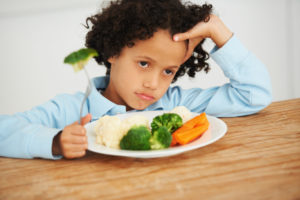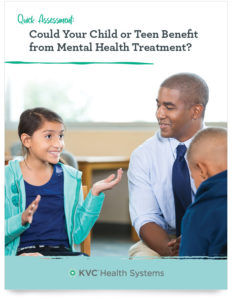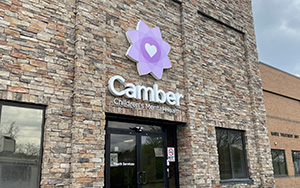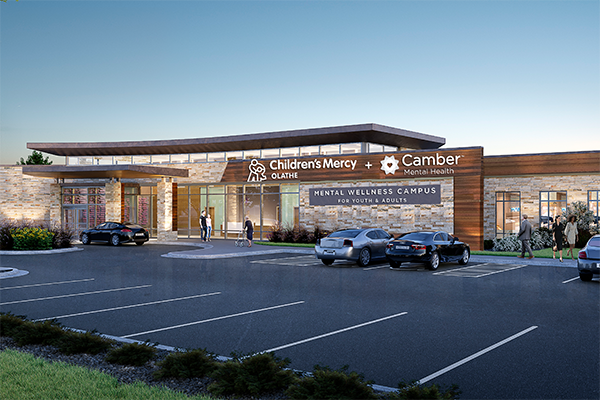Uncovering the Most Common Mood Disorders in Children

Figuring out what’s bothering a child or teenager is no easy task. Are they in physical discomfort, such as tired or hungry? Or are they upset about something that happened at school or with a friend?
Even though they can’t talk, sometimes understanding babies’ moods can be simpler than with older kids. Babies are most likely hungry, tired or need a clean diaper. But with kids and teens, getting answers that accurately describe how they’re feeling doesn’t seem to get easier even as they get older. This is why anyone spending time with children should observe behaviors, actions, and overall mood changes. When kids have frequent severe episodes or mood swings, these can be indicative of a mood disorder. Recently, our clinical team gave presentations for Mental Health America of the Heartland on Current Practices in the Diagnosis and Treatment of Mood Disorders in Children and Adolescents. Let’s look at some of the information they covered and more!
What is a mood disorder?
Mood disorders are a type of mental health disorder that affects people of all ages. More than just the occasional “bad mood” or “moodiness,” people with mood disorders experience persistent, unmanageable symptoms. These symptoms can vary between individuals and manifest differently based on types of mood disorders.
Some mood disorders lead to depressive states. This might present itself with a loss of appetite, struggles with sleep, trouble concentrating and other similar symptoms. Others lead to manic states, which may include symptoms such as irritable moods, racing thoughts and erratic movements.
These are just some of the different symptoms that occur during episodes or periods when mood disorder symptoms are severe. If someone has a mood disorder, they might not be able to function in social settings. Basic tasks might even be difficult to perform.
Mood Disorders in Children

We tend to think of adults when we think about mental health disorders. Children cry often over things like skinned knees or sandwiches cut the “wrong” way. Having too much sugar can even cause children to display behaviors that appear to be manic-like. And teens are notoriously “moody.” With crushes, friend group drama, academic challenges, and acne or weight fluctuations due to hormones, being a teen is not easy. But children and teens can also have serious mood disorders just as adults do.
Mood disorders in children can be more difficult to diagnose than in adults because they often can’t explain what they are feeling or how it feels. If your child’s behavior or attitude is consistently unexplainable, it could be more than just a typical developmental stage or behavior. It’s also true that children are more likely to have mood disorders if their parents have one. Hardships in life can also worsen symptoms of a mood disorder. It’s important to know what your child’s “normal” behavior looks like. Observe and pay close attention to behavior changes to recognize the hallmarks of mood disorders.
The most common mood disorders in children include:
- Major depression: A depressed or irritable mood, potentially along with other signs, that lasts for at least 2 weeks. The youth may also lose interest or pleasure in activities they may typically enjoy.
- Persistent depressive disorder (dysthymia): A youth with this has a long-lasting, low-grade, depressed or irritable mood for at least 1 year.
- Bipolar disorder: This causes a mix of manic episodes and depressed periods, or times of flat or dulled emotional response.
- Disruptive mood dysregulation disorder: A youth with this disorder has ongoing grouchiness and difficulty controlling their behavior.
- Premenstrual dysmorphic disorder: This causes depressive symptoms, grouchiness, and tension before a menstrual period.
- Mood disorder caused by a health problem: Many conditions can trigger symptoms of depression. These include cancer, injuries, infections and chronic illnesses.
- Substance-induced mood disorder: These are depression symptoms from the effects of medicine or other forms of treatment, substance use or exposure to toxins.
Understanding Bipolar and Depressive Disorders
Bipolar Disorder
Involves episodes of both depression and mania. When a child or teen has a bipolar disorder, they will exhibit multiple symptoms of a depressive state, including:
- Irritability
- Sadness
- Anger
- Hypersomnia or insomnia
- Decrease in energy
- Decreased interest in activities or relationships
- Changes in appetite
- Isolating behaviors
- Feelings of hopelessness or worthlessness
- Thoughts of death
They may also display any of these symptoms of a manic state:
- Intense happiness or silliness
- Risky or impulsive behaviors
- Racing thoughts
- Poor judgment
- Substance use
- Hypersexual actions
- Decreased need for sleep
Depressive Disorders
Includes Disruptive Mood Dysregulation Disorder, Major Depressive Disorder, Persistent Depressive Disorder (Dysthymia), and Premenstrual Dysphoric Disorder. These differ in exact symptoms and duration of symptoms, but most depressive disorders result in similar symptoms or behaviors, including:
- Changes in weight or appetite
- Hypersomnia (excessive sleepiness) or insomnia (difficulty falling asleep or staying asleep)
- Psychomotor agitation (erratic, non-goal oriented movements)
- Fatigue or loss of energy
- Feelings of worthlessness or guilt
- Decreased concentration or ability to make decisions
- Recurrent thoughts of death or suicide, or a suicide attempt
Difference Between Trauma Response and Mood Disorders
If a child has been through trauma, their response to the trauma may appear similar to symptoms of a mood disorder. Childhood trauma includes things like:
- Abuse (physical, emotional, sexual)
- Neglect
- A deceased, mentally ill or incarcerated parent
- Parental drug use
- Divorce
- Witnessing domestic violence
- Bullying
- Natural disasters
- Effects of isolation or anxiety from the COVID-19 pandemic
- Discrimination based on race, gender, religion, sexual orientation/identification, disability, or other attributes
Other mental health challenges that are commonly paired with a mood disorder diagnosis in children and teens include:
- Post-traumatic stress disorder
- Anxiety disorder (and more specifically, separation anxiety disorder)
- Substance disorders
- Attention Deficit Hyperactivity Disorder (ADHD)
- Enuresis or Encopresis (more commonly known as bedwetting or soiling)
What to Do If You’re Concerned About Your Child’s Behavior
If you’re unsure about your child’s behaviors, pinpoint the onset of symptoms and the specific behaviors that are concerning you. Determine if any traumatic events have occurred in your child’s life that might be linked to some of the behaviors. And most importantly, talk to your child’s primary physician or a licensed mental health provider and ask for a professional evaluation.
 Camber provides a free mental health assessment that can help you answer some initial questions about your child’s behaviors. Click here to download it now. This assessment is not intended to replace the advice of a professional doctor or mental health counselor.
Camber provides a free mental health assessment that can help you answer some initial questions about your child’s behaviors. Click here to download it now. This assessment is not intended to replace the advice of a professional doctor or mental health counselor.
About Camber (Previously KVC Hospitals)
Camber provides compassionate and innovative treatment for children struggling with mood disorders, depression, anxiety, suicidal thoughts, the impacts of trauma and other mental health needs. Our children’s mental health hospitals and residential treatment facilities are available 24/7 by phone to answer any questions you have. Click here to find a location near you.






